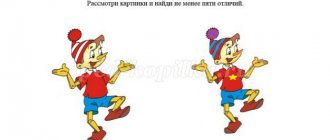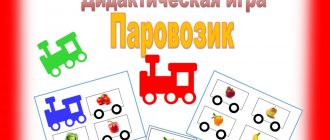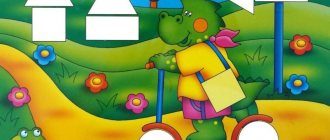Didactic game: “Correct Score”
Quantity and count
Didactic game: “Correct Score”
Goal: to help master the order of numbers in the natural series; strengthen forward and backward counting skills.
Equipment: ball.
Content: children stand in a circle. Before starting, they agree in what order (direct or reverse) they will count. Then they throw the ball and string a number. The one who caught the ball continues counting by throwing the ball to the next player
Didactic game: “A lot and a little”
Goal: to help understand the concepts of “many”, “few”, “one”, “several”, “more”, “less”, “equally”.
Content: ask the child to name single objects or objects that are many (few). For example, there are many chairs, one table, many books, few animals. Place cards of different colors in front of the child. Let there be 7 green cards and 5 red cards. Ask which cards are more and which are fewer. Add 2 more red cards. What can we say now?
Didactic game: “Guess the number”
Goal: to help prepare children for basic mathematical operations of addition and subtraction; help consolidate the skills of determining the previous and subsequent numbers within the first ten.
Content: ask, for example, which number is greater than three but less than five; what number is less than three but greater than one, etc. Think of, for example, a number within ten and ask the child to guess it. The child names different numbers, and the teacher says more or less than the intended number. Then you can switch roles with your child.
Didactic game: “Counting mosaic”
Purpose: to introduce numbers; learn to match quantities with numbers.
Equipment: counting sticks.
Contents: Together with your child, make up numbers using counting sticks. Invite the child to place the corresponding number of counting sticks next to the given number.
Didactic game: “Read and count”
Purpose: to help master the concepts of “many”, “few”, “one”, “several”, “more”, “less”, “equally”, “as much”, “as much”; the ability to compare objects by size; ability to count within 5.
Equipment: counting sticks.
Contents: while reading a book to a child, ask him to put aside as many counting sticks as, for example, there were animals in the fairy tale. After counting how many animals there are in the fairy tale, ask who there were more, who were fewer, and who were the same. Compare toys by size: who is bigger – a bunny or a bear? Who is smaller? Who is the same height?
Didactic game “Take the same amount”
Goal: to practice composing two equal groups of objects, to activate the vocabulary of “the same”, “equally”.
Equipment. Children have a table with three stripes, divided vertically into three equal parts.
Contents: on the left side of the card various objects are depicted (from 1 to 5, sets of geometric shapes and counting sticks.
The teacher suggests looking at the tables and telling them what is drawn on them. Then the children fill out the middle (vertical) part of the table, taking the same number of geometric shapes as there are objects depicted in each cell. The teacher asks the child how many figures he placed and suggests checking the correctness by overlapping. After filling out the middle part of the table, children take counting sticks and place them on the right side of the table according to the number of objects drawn.
Geometric shape
Wonderful pouch
Purpose of the game: To train children to determine what kind of object it is by its characteristic external features, that is, by its shape.
How to play: To play, you will need a fabric bag made of thick, opaque fabric, into which objects of different shapes and textures are placed. I suggest identifying each item by touch without looking into the bag. You can also hide geometric shapes in it, the child must guess by touch which shape is hidden.
Find out the figure
Purpose of the game: improve the perception of shape, develop voluntary attention, speed of movements.
Material: cards with images of geometric shapes - square, triangle, circle or objects similar to these shapes - wheel, pyramid, modules.
Progress of the game: The teacher introduces the children to the prepared geometric shapes, which he places in different parts of the room, and explains the rules of the game. At a signal, children move randomly around the hall, performing various movements. After the teacher names one of the figures, for example, “Square”, the children should quickly build around this figure.
Children who complete the task quickly and correctly are recognized.
Rolling - not rolling
Purpose of the game: to introduce three-dimensional geometric bodies - a cube and a ball.
Equipment: cubes and balls of different sizes and colors.
Progress of the game: show the children a ball, then a cube, accompanying the actions with the words: “This is a ball, it rolls - like this. The balls are smooth. Touch it. And this is a cube. Can the cube roll? No, he can not. But it has corners, touch them.” Give the children one cube and one ball each and invite them to play with them: put them on the floor, on the table, on top of each other, roll them, etc. Then ask them to put the objects in boxes: the balls in one box, and the cubes in another.
Quantities.
Didactic game:
"Which one has the longest tail?"
Goal: Mastering the ability to compare objects of contrasting sizes in length and width, to use in speech the concepts: “long”, “longer”, “wide”, “narrow”.
Content. Noise outside the door. Animals appear: a baby elephant, a bunny, a bear, a monkey - friends of Winnie the Pooh. Animals argue about who has the longest tail. Winnie the Pooh invites children to help the animals. Children compare the length of the ears of a hare and a wolf, the tails of a fox and a bear, the length of the neck of a giraffe and a monkey. Each time, together with V., they define equality and inequality in length and width, using the appropriate terminology: long, longer, wide, narrow, etc.
Didactic game:
"Who will roll the tape sooner"
Goal: continue to form an attitude towards size as a significant feature, pay attention to length, introduce the words “long”, “short”.
Content. The teacher invites the children to learn how to roll the ribbon and shows how to do it, and lets everyone try it. Then he offers to play the game “Who will roll the tape first?” Calls two children, gives one a long ribbon, the other a short one, and asks everyone to see who will be the first to roll up their ribbon. Naturally, the one with the shorter ribbon wins. After this, the teacher lays out the ribbons on the table so that their difference is clearly visible to the children, but does not say anything. Then the children change ribbons. Now the other child wins. Children sit down, the teacher calls the children and invites one of them to choose a ribbon. He asks why he wants this tape. After the children’s answers, he names the ribbons “short” and “long” and summarizes the children’s actions: “The short ribbon rolls up quickly, and the long ribbon rolls up slowly.”
Didactic game: “Elevator”
Goal: to consolidate forward and backward counting to 5, to consolidate the basic colors of the rainbow, to consolidate the concepts of “up”, “down”, to remember ordinal numbers (first, second)
Contents: The child is asked to help residents raise or lower them on the elevator to the desired floor, count floors, find out how many residents live on the floor.
Time oriented
Didactic game:
"Name the missing word"
Goal: learn to name time periods: morning, evening, day, night.
Equipment: ball.
Contents: Children form a semicircle. The teacher rolls a ball to one of the children. Begins a sentence, omitting the names of parts of the day: - We have breakfast in the morning and lunch. Children name the missing word. - In the morning you come to kindergarten and go home... - In the afternoon you have lunch and dinner...
Didactic game:
“Who came first? Who's later?
Goal: to consolidate children's knowledge about time representations: first, then, before, after, earlier, later.
Contents: Staging of fairy tales using illustrations “Turnip”, “Teremok”, “Kolobok”, etc.
Didactic game
"Yesterday Today Tomorrow"
Goal: To consolidate the concept of such categories as “yesterday”, “today”, “tomorrow”
Material: Ball
Contents: The presenter throws the ball to everyone playing in turn and says: “We sculpted when.” The catcher finishes the phrase, as if answering the question “when?”
We'll go for a walk in the park. (Today)
We visited our grandmother. (yesterday)
We will read a book. (Tomorrow)
Didactic game “What has changed?”
Goal: to develop children's attention and memory.
Content: Children form a circle. There are several children standing inside the circle. At a sign from the teacher, one leaves, then, upon entering, he must determine what changes have occurred inside the circle. In this version, the guessing child must count how many children stood in the circle at the beginning, how many remained, and, by comparing these two numbers, determine how many children left the circle. Then, when repeating the game, the guesser must name the name of the departed child. And to do this, you need to remember the names of all the children standing in the circle and, looking at the rest, determine who is missing. A further complication could be this: the number of children in the circle remains the same (within five, but their composition changes. The guesser must say which of the children left and who took his place. This option requires more attention and observation from children.
Quantity and count
Didactic game: “Correct Score”
Goal: to help master the order of numbers in the natural series; strengthen forward and backward counting skills.
Equipment: ball.
Content: children stand in a circle. Before starting, they agree in what order (direct or reverse) they will count. Then they throw the ball and string a number. The one who caught the ball continues counting by throwing the ball to the next player
Didactic material for familiarization with the composition of the number of units in the senior group
Nelya Tkachenko
Didactic material on knowing the composition of the number of units in the senior group
Didactic material for knowledge
with a composition of people from the senior group.
SPHERE:
Forming ideas about the composition of the number inside the first bead.
TASKS:
- regulate, -
– ideas about numbers and numbers inside the first bead;
- develop,-
– the idea that all numbers are made of ones;
– the idea that the number of units in different quantities is different;
– attention, visual perception, memory, logical thinking;
– excellent motor skills;
- mention -
– organization;
– concentration;
– interest in mathematical games;
The calculation of the activity of five-year-olds in the process of systematic learning is already objectively perfect. Studying the composition of the number of units in the senior group is preparation for mastering computer technology - counting and counting one at a time.
What else to read: Didactic game “Berry, Vegetable or Fruit?” 5-6 grade
The study of the composition of numbers from units should begin with an analysis of the composition of a set of elements to the composition of a number of units, while one should be consistent, not hasty, and from the heel - from each number - from 2 to 5 (2, 3,4,5)
... For illustrative purposes of the material, a group of objects of the same type is selected, each of which differs from each other in qualitative characteristics (for example, color, size) ... In addition, elements that are united by a concept are used in the future, for example, sets of clothes, dishes, furniture, etc. etc. Along with texture elements, you can use patterns of geometric shapes, strips of paper of different lengths and sizes, etc. It is necessary to teach children, when looking at the sets, to tell how this group is composed, to name each element and their total number.
For example:
“The number 4 consists of the following: 1 green circle, 1 red circle. 1 yellow circle, 1 blue circle – 4 circles in total.”
After counting 4 circles, the child must say how it is composed “that’s four”
emphasizing the number of composition: one - green, one - red, one - yellow, one - blue, four in total. When inviting children to do tasks with different types of groups of objects, you should ask them to say how the group is made up, how many different objects there are and how many there are in total, to name both the objects and their number. Gradually you should move from more specific questions to general ones: “How much did you receive? How much... in total? How do you... (for example, 5 pencils?"
When studying the quantitative composition of a number of units, it is necessary to draw children's attention to the fact that a unit can reflect not only an individual object, but can be a reflection of an entire group of objects. For example, invite children to look at a variety of geometric shapes and answer questions:
– What parts does this set consist of? ("Compiled in three parts"
.
– Name the color and number of parts of this set. (“This set consists of three parts of different colors: one part is red triangles, one is blue triangles, the third is green triangles. There are three parts in total.”
– How many units does the number three consist of? ("Of three separate units"
).
In this task, children must understand that a unit can reflect not only an individual object, but also a group of objects.
In the process of familiarizing children with the composition of a number of units, you can use verbal exercises, -
– forest animals gathered in the clearing: a hare, a hedgehog, a squirrel. How many animals are gathered in the forest clearing? How many different forest animals have gathered in the clearing, etc.
And other tasks, for example -
– take five triangles of different colors;
– draw three different geometric shapes;
– put four different dolls on the table, etc.
Familiarization of children with the composition of a number is carried out in a sequential system of classes, which creates conditions for the formation of new connections that form children's knowledge of quantitative composition, which in turn is preparation for computing activities.





